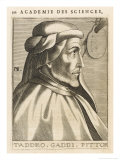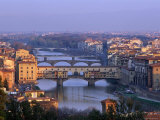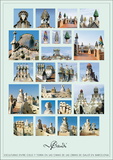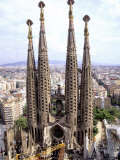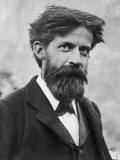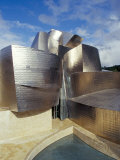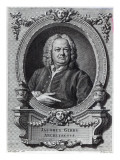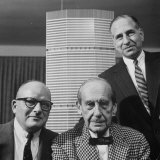|
|
|
|
Taddeo Gaddi
b. c. 1300; Florence, Italy
d. c. 1366; Florence
Medieval architect and painter Taddeo Gaddi is generally credited as the designer of the Ponte Vecchio. The Ponte Vecchio, literally “Old Bridge”, consists of three segmental stone arches with shops built along the span, and crosses the Arno River at its narrowest point in Florence.
FYI - Supposedly the term bankrupt originated on the Ponte Vecchio - when a merchant could no longer pay his debts, his banca, or table, was smashed, "rotto", for “banca rotta”. Also the Ponte Vecchio was not destroyed in World War II by the retreating Germans in 1944, allegedly because Hilter expressly forbade its destruction.
|
|
|
|
Antonio Gaudi
b. 6-25-1852; Reus, Catalonia, Spain
d. 6-10-1926; Barcelona
Antonio Gaudi, notable for his unique style and highly intricate designs, was afflicted with inflammation of the joints from childhood, making moving about painful and thus providing the opportunity to look carefully and think creatively rather than rushing around.
Gaudi's careful observations of nature, the Spanish gothic style, and his faith are expressed in the massive Sagrada Famila Catholic church in Barcelona, under construction since 1882.
• Antonio Gaudi: Master Architect
|
|
|
|
Patrick Geddes
b. 10-2-1854; Ballater, Scotland
d. 4-17-1932; France
Biologist Patrick Geddes is best remembered for his innovative thinking in the fields of urban planning.
Geddes introduced the concept of “region” to architecture and planning and coined the word “conurbation” in 1915 to describe the melding of cities and towns into one continuous urban and industrially developed area.
Geddes promoted the idea he shared with John Ruskin that spatial form and social processes are related and influence one another. His plan for Bombay included the following -
- Preservation of human life and energy, rather than superficial beautification.
- Conformity to an orderly development plan carried out in stages.
- Purchasing land suitable for building.
- Promoting trade and commerce.
- Preserving historic buildings and buildings of religious significance.
- Developing a city worthy of civic pride, not an imitation of European cities.
- Promoting the happiness, health and comfort of all residents, rather than focusing on roads and parks available only to the rich.
- Control over future growth with adequate provision for future requirements.
FYI - the city of Tel Aviv's center is built to Geddes master plan.
Geddes was also interested in education, the science of ecology, nature conservation and pollution. He is considered a forerunner of modern Green politics.
|
|
|
|
Frank O. Gehry
b. 2-28-1929; Toronto, Canada
Frank Gehry, born Ephraim Owen Goldberg, designs buildings that are “destinations”, attracting tourists and sightseers.
Gehry's best known works include the titanium-covered Guggenheim Museum in Bilbao, Spain; Walt Disney Concert Hall in downtown Los Angeles; Dancing House in Prague, Czech Republic; and his private residence in Santa Monica, California.
• Frank O. Gehry: The Complete Works
|
|
|
|
James Gibbs
b. 12-23-1682; Aberdeen, Scotland
d. 9-5-1754; London
James Gibbs' most notable works are St Martin-in-the-Fields, in London, and the cylindrical, domed Radcliffe Camera at Oxford University.
FYI - in architecture “camera” is a suite of rooms, from the Latin camera = chamber.
|
|
|
|
|
|
|
Walter Burley Griffin
b. 11-24-1876; Maywood, Illinois
d. 2-11-1937
Walter Burley Griffin, architect and landscape architect, is best known for his part in designing Canberra, Australia's capital city. Griffin, associated with the Prairie School of architecture, has been credited with the L-shaped floor plan, the carport, and the first use of reinforced concrete.
Walter was also the husband of fellow architect Marion Mahony Griffin (1871-1961) who is best remembered for her architectural renderings.
• Walter Burley Griffin in America
• Marion Mahony Griffin: Drawing the Form of Nature
|
|
|
|
|
|
previous page | top | next
architecture | architects list | a | b | c | d-e-f | G |
h | i-j | k-l | m | n | o-p | r | s | t-v | w-x-y-z
|
|
I have searched the web for visual, text, and manipulative curriculum support materials - teaching posters, art prints, maps, charts, calendars, books and educational toys featuring famous people, places and events - to help teachers optimize their valuable time and budget.
Browsing the subject areas at NetPosterWorks.com is a learning experience where educators can plan context rich environments while comparing prices, special discounts, framing options and shipping from educational resources.
Thank you for starting your search for inspirational, motivational, and educational posters and learning materials at NetPosterWorks.com. If you need help please contact us.
|
|
|










